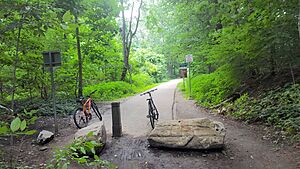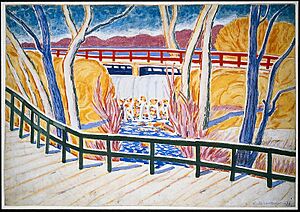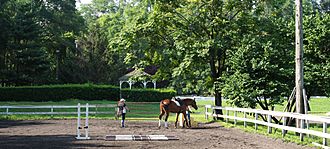Van Cortlandt Park facts for kids
Quick facts for kids Van Cortlandt Park |
|
|---|---|
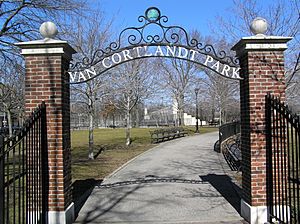
An entrance to Van Cortlandt Park
|
|
| Type | Municipal |
| Location | The Bronx, New York City, New York, US |
| Area | 1,146 acres (464 ha) |
| Created | 1888 |
| Operated by | NYC Parks |
| Status | Open |
| Public transit access | New York City Subway: Woodlawn ( New York City Bus: Bx9, Bx10, Bx16, Bx34 local buses, BxM3, BxM4 express buses Bee-Line Bus System: 1, 2, 3, 4, 20, and 21 |
Van Cortlandt Park is a huge park in the Bronx, New York City. It covers about 1,146-acre (464 ha), making it the third-largest park in the city. The park is owned by the New York City Department of Parks and Recreation and is looked after with help from the Van Cortlandt Park Alliance. It was named after the Van Cortlandt family, who were important in the area long ago.
Van Cortlandt Park is a great place for sports and outdoor fun. It has golf courses, miles of running paths, and fields for baseball, basketball, cricket, football, lacrosse, rugby, soccer, and softball. You can also go horseback riding, swimming, or play tennis. The park also has five main hiking trails and other walking paths.
Nature lovers will enjoy Tibbetts Brook, Van Cortlandt Lake (the biggest freshwater lake in the Bronx), old forests, and cool rock formations. Inside the park, you'll find the Van Cortlandt House Museum, which is the oldest building still standing in the Bronx. The Van Cortlandt Golf Course is also the oldest public golf course in the whole country!
The land for the park was bought by Jacobus Van Cortlandt around 1691. His son, Frederick, started building the Van Cortlandt House. During the American Revolutionary War, the land was used by soldiers. In 1888, the Van Cortlandt family sold the property to New York City, and it became a public park. The Van Cortlandt House became a museum, and new paths were built for visitors.
In the 1930s, new highways like the Henry Hudson Parkway and Mosholu Parkway were built, which split the park into six separate pieces. This construction also changed Tibbetts Brook, causing some harm to the park's natural environment. After a financial crisis in New York City in the 1970s, parts of the park became run down. But since the late 1980s, many improvements have been made, including new paths, signs, and better security. In 2014, a plan called "Van Cortlandt Park Master Plan 2034" was made to guide future improvements.
Contents
Park History
Early People and Settlers
The forests in Van Cortlandt Park have been here for about 17,000 years! The Wappinger people, called the Wiechquaskeck, were some of the first people to live here around the 14th or 15th centuries. They used the land's features, like Tibbetts Brook and the Hudson River, for fishing and farming. They had a village called Keskeskick, which means "sharp grass or sedge marsh."
In the early 1600s, a Dutch settler named Adriaen van der Donck bought land from the Dutch West India Company and also paid the local Indian chief. He built a house and farmed the area where the park's parade ground is now.
After van der Donck died, the land changed hands a few times. Eventually, parts of it were sold to William Betts and George Tippett (who Tibbetts Brook is named after). Later, a large piece of land, including where the Van Cortlandt House stands, became part of the Philipsburg Manor.
The Van Cortlandt Family and the Lake
The Van Cortlandt family bought the land in the late 1690s. In 1699, Jacobus Van Cortlandt built a dam on Tibbetts Brook to power a sawmill. This created Van Cortlandt Lake, which was used as a mill pond. In 1732, the family got even more land.
Frederick Van Cortlandt built the famous Van Cortlandt House in 1748, but he passed away before it was finished. The family mostly lived in Manhattan. A family burial ground, called "Vault Hill," was created in 1749.
Revolutionary War History
The Van Cortlandt family's land was important during the American Revolutionary War. Both American and British soldiers used the area. James Van Cortlandt, a family member, helped plan a fort near his house. In 1776, British General William Howe used the house as his headquarters.
Even though the Van Cortlandts tried to stay neutral, famous American leaders like George Washington, Marquis de Lafayette, and Comte de Rochambeau used the house. Washington even hid city records under Vault Hill to keep them safe during the war. In 1778, a group of Native American soldiers, the Stockbridge militia, had a battle here, and many were killed. Washington later used the house to plan with Rochambeau and to trick the British into thinking his troops were still there.
Water for the City
In the 1830s, New York City needed more water. Engineers decided to build the Croton Aqueduct, a long water pipe, right through what is now the park. Construction started in 1837 and took five years. Workers built a special building in the park to get inside the aqueduct. A newer aqueduct was built in 1890, also running through the park. The old aqueduct was used until 1955.
How the Park Was Planned
In 1876, Frederick Law Olmsted, who designed Central Park, looked at the Bronx and suggested the city buy the Van Cortlandt property because of its beauty. A newspaper editor named John Mullaly also pushed for new parks in New York City. He started the New York Park Association in 1881.
Some people didn't want the parks because they thought they were too far from Manhattan or would cost too much. But supporters argued that parks were good for everyone and would make nearby property more valuable. In June 1884, a law was signed to create the park system. Even with some disagreements, the parks were established.
In 1880, while the park was being planned, the New York City & Northern Railroad built tracks through the park. It had two stops in the Bronx, one inside the park. These tracks were used for passengers until 1958 and for freight until 1981.
Creating the Park
The Van Cortlandt family sold their land to New York City in 1888, and it officially became a public park. Most of the old grain fields were turned into a large lawn called the "Parade Ground." The Van Cortlandt House became a public museum. Workers cleared overgrown areas and built wide walking paths, including ones to the family cemetery.
The nine-hole Van Cortlandt Golf Course opened on July 6, 1895. It was the first public golf course in the country! Four years later, it was expanded to 18 holes. A clubhouse was added in 1902.
At first, not many people used the park for sports. But by 1902, the Parade Ground was used for polo. In 1907, some bison from the Bronx Zoo even stayed on the Parade Ground for a short time before moving to Oklahoma.
A "Colonial Garden" with plants, bridges, and a fountain opened in 1903. A "Shakespeare Garden" also opened. But these gardens had problems with drainage and needed to be rebuilt.
Early Park Changes
Over the years, many changes were made. Roads were built through the park, making it easier for visitors to reach picnic areas and hiking trails. In 1906, a stone memorial was placed at Indian Field.
People were worried about mosquitoes in the wetlands, so between 1906 and 1922, some marshlands were filled in. Van Cortlandt Lake was also cleaned and deepened between 1903 and 1911.
During World War I, the Parade Ground was used to train soldiers. More tennis courts and another golf course, the Mosholu Links, opened in 1914. The park's sports facilities became very popular, with thousands of people using them on busy days.
A 6.2-mile (10.0 km) cross-country running course opened in 1914. It had flat parts, hills, and even went through a forest and over water. In 1921, a shorter 3.1-mile (5.0 km) course opened.
In 1934, Robert Moses became the New York City Parks Commissioner. He made many changes to the park. He planned for the Henry Hudson Parkway and Mosholu Parkway to go through the park. This construction split the park into six pieces and removed most of the remaining marshland.
Moses also improved the park itself by building new walkways, paving dirt roads, creating playgrounds, and adding lights. Baseball, soccer, and cricket fields were added in 1938. The Van Cortlandt Stadium was built in 1939, and a pool followed in 1970. Moses also made areas near the subway stations nicer to attract more visitors.
Park Challenges
By the 1960s, parts of the park, like Tibbetts Brook, were getting polluted. Chemicals from the golf course and highways killed fish in Van Cortlandt Lake. In 1961, thousands of dead fish were found. The lake became very dirty, and by 1976, boating was stopped.
The Van Cortlandt Golf Course was used for skiing in the winters starting in 1961. But this stopped in the late 1960s. Public pools were built in 1970 on the site of the old Colonial Garden. However, due to the swampy ground, the pools started to crack.
The city's financial problems in the 1970s caused the park to fall into disrepair. There wasn't enough money for upkeep. Pollution worsened, and walking paths became eroded. The golf courses also suffered, with weeds growing everywhere and some trees dying. In 1985, a company took over managing the golf courses and helped restore them.
Vault Hill, the family burial ground, was also vandalized in the 1960s. Jogging tracks and bridle paths became overgrown. Even the popular Parade Ground deteriorated.
Park Improvements
In response to the park's poor condition, efforts began to improve it. In 1978, the state helped restore the fish population in the lake. Groups like the Friends of Van Cortlandt Park offered ideas for improvements.
Gradual changes started in the late 1980s, including new paths, signs, and better security. Playgrounds and other sports areas were also fixed up. In the 1990s, an excavation found over 2,500 old items.
The city built a large water treatment plant, the Croton Water Filtration Plant, under the Mosholu Golf Course. It started working in 2015 to clean drinking water. This plant was built after a lawsuit to make sure the city's water was safe. The plant cost $3.2 billion and is 160 feet (49 m) underground.
To make up for the construction, money from the plant's budget was used to fix up the Van Cortlandt Park Parade Ground in 2010. The Sachkerah Woods Playground was also built with these funds.
The "Van Cortlandt Park Master Plan 2034" aims to restore the park's natural areas, like the forest and Tibbetts Brook. It also plans for new pedestrian bridges, a playground, activity centers, a skate park, and more sports fields. The Van Cortlandt Golf Course was renovated in 2016. The skate park and new playground were finished in 2020.
Park Geography
Van Cortlandt Park is 1,146 acres (464 ha) big, making it the third-largest park in New York City. It has many fun and educational things to see and do.
Park Geology
The park's different areas have interesting rocks. The Northwest Woods has very hard rocks called Fordham gneiss. The Tibbetts Brook valley has Inwood marble, which is softer. The east side of the park has Yonkers granite, which mixed with the Fordham gneiss long ago.
Park Waterways
Van Cortlandt Park has the Bronx's biggest freshwater lake, Van Cortlandt Lake. The lake is about 18 acres (7.3 ha) and 4 to 8 feet (1.2 to 2.4 m) deep. You can fish here for different types of fish like bass, crappie, and carp.
The lake is fed by Tibbetts Brook, a stream that starts in Yonkers. In 1699, Jacobus Van Cortlandt built a dam on the brook to create the lake for his sawmill. The sawmill was used until 1889, and a gristmill was added later.
When the park was created, Van Cortlandt Lake was dirty because of sewage from Yonkers. Cleaning started in 1903. The old dam was removed, the lake was emptied, and a lot of mud was dug out. A new wall and dam were built to make the lake better.
People also disliked the wetlands near the lake because they thought mosquitoes that carried malaria lived there. Some wetlands were filled in, but some still remain.
In its early years, the lake was used for boating, canoeing, curling, and ice skating. Thousands of people would skate on the lake in winter.
Park Wildlife
The park has several old forests with many types of trees like black oak, hickory, and maple. You can also see wild turkeys, red-tailed hawks, great horned owls, bats, chipmunks, squirrels, groundhogs, raccoons, deer, and even coyotes! Over 130 types of butterflies live here.
In the marshlands, you might spot red-winged blackbirds, yellowthroats, beetles, dragonflies, and herons. The park has more bird species in winter than Central or Prospect Parks. Since 1875, 301 different bird species have been seen here. You might also find frogs, salamanders, and turtles in the park's water areas.
Park Landmarks and Structures
Park Trails
Van Cortlandt Park has five main hiking trails:
- The Putnam Trail (1.5 miles (2.4 km), easy) goes north through the woods and golf course. It follows an old railroad line into Yonkers. This trail was paved in 2020 for walkers and bikers. You can still see parts of the old Van Cortlandt Park train station along the trail.
- The Old Croton Aqueduct Trailway (1.1 miles (1.8 km), easy/moderate) was created in 1968. It follows the path of an old brick tunnel that brought water to Manhattan. You can see parts of the old tunnel and a gatehouse. A bridge is planned to connect two parts of this trail.
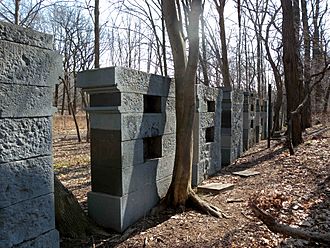
- The John Kieran Nature Trail (1.25 miles (2.01 km), easy) opened in 1987. It's named after a local writer. This path has 13 stone pillars, each made of a different type of stone. These stones were tested for the outside of Grand Central Terminal. The trail goes along Van Cortlandt Lake and the Tibbetts Brook marsh.
- The John Muir Trail (1.5 miles (2.4 km), moderate) is the only east-west trail in the park. It was made in 1997. You can see many types of trees and flowering plants along this trail.
- The Cass Gallagher Nature Trail (1.4 miles (2.3 km), moderate/difficult) is the hardest trail. It's named after a local person who worked hard to protect the park. This loop trail goes through rocky forests. You can see very old trees and exposed rocks with mica and quartz. Many birds like woodpeckers and owls have been seen here.
A bikeway also runs from the golf course clubhouse to the Mosholu Parkway bike path. Some parts of the park's trails are part of the East Coast Greenway, a very long trail system from Maine to Florida.
Park Landmarks
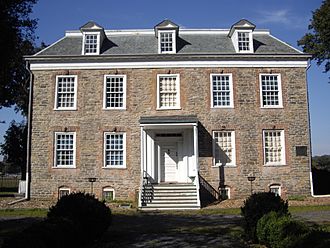
The Van Cortlandt House in the southern part of the park was built in 1748. It's the oldest building still standing in the Bronx! This house was very important during the American Revolution, used by both American and British troops. In 1886, the Van Cortlandt family sold the house and land to New York City. Ten years later, it became a museum to show what life was like in the 1700s. It's now a national historic landmark.
Near the museum, there's a 15-mile marker from the old Albany Post Road. Vault Hill, the family burial ground, is still there, northeast of the Parade Ground.
The Memorial Grove honors people from the Bronx who served in World War II and the Korean War. It's located near the Van Cortlandt House. It was created in 1949 with trees and plaques for soldiers.
Other Structures
Van Cortlandt Park has the Citywide Nursery, one of three greenhouses run by NYC Parks. It grows about 200,000 plants every year.
Park Recreation
The Parade Ground is a large open area north of the museum. It used to be used by the National Guard for training. Now, it has 17 fields for baseball, football, or soccer, and two fields just for cricket. It has 10 of the Bronx's 19 cricket fields! The cricket fields were updated from 2010 to 2013. The Parade Ground also has a 1.5-mile (2.4 km) course for cross-country running. The famous band The Rolling Stones even started their "Licks Tour" here in 2002!
The park has a free public pool, many playgrounds, and areas for barbecuing. The pool opened in 1970 and has a wading pool, a diving pool, and an Olympic-sized pool.
The Van Cortlandt Stadium was built in 1939 during the Great Depression. It has tennis courts, basketball courts, handball courts, baseball fields, football fields, a running track, and a bowling green. The running track was rebuilt in 1998. It's the home field for the Manhattan College Jaspers baseball team.
Riverdale Stables, covering 21 acres (8.5 ha) of the park, offers horseback riding.
Indian Field has baseball and softball fields, a sandbox, picnic tables, tennis courts, and shuffleboard courts. The Allen Shandler Recreation Area has baseball fields, benches, picnic tables, and barbecue grills. Other activities in the park include basketball, ice skating, and fishing.
Park Golf

The Van Cortlandt Golf Course opened on July 6, 1895, with nine holes. It quickly became very popular. Rules were set in 1896, and golfers paid caddies to carry their clubs. Bicycles and strollers were not allowed on the course.
The course was expanded to 18 holes in 1899 and a clubhouse was added in 1902. On July 13, 1905, Isaac Mackie won the first professional golf tournament ever held on a public golf course in the United States here.
In 1914, a second golf course, the Mosholu Golf Course, opened next to the Van Cortlandt Park course. Both courses were used a lot. Parts of the Van Cortlandt course were rebuilt when the Henry Hudson Parkway was constructed.
In 2002, a First Tee course for young golfers opened at the Mosholu course. The Van Cortlandt Golf Course and its clubhouse were renovated from 2007 to 2014, with new greens and a better drainage system.
Park Running
Van Cortlandt Park is a very popular place for cross-country running because of its trails and hills. Some say its courses are among the most used in the United States.
Around the Parade Ground, there's a 1.5 miles (2.4 km) track. Another 1.25-mile (2.01 km) rubber trail and a 3.1-mile (5.0 km) cross-country trail are also available. Runners on the cross-country course usually run 6.2 miles (10.0 km). They start at the Parade Ground and go through different sections like "the cowpath" and "the back hills." This trail was renovated in 1997.
The park hosts big running events like the Northeast regional championships for the Foot Locker Cross-Country Championships and the Manhattan College Invitational for high school runners. It's also the home course for several colleges, including Fordham University and Manhattan College.
City's Only Canadian Football Game
On December 11, 1909, two Canadian football teams, the Hamilton Tigers and the Ottawa Rough Riders, played an exhibition game at Van Cortlandt Park. Between 5,000 and 30,000 people watched Hamilton win 11-6. It was the first important Canadian football game played in the U.S.
Park Management
Before 1992, private groups didn't help maintain the park. The first efforts for this started in 1983.
Even though NYC Parks owns and runs the park, until 2019, two different non-profit groups helped with its care. The Van Cortlandt Park Conservancy managed educational programs and recreational areas. The Friends of Van Cortlandt Park helped with educational programs and natural areas. These groups didn't have as much money as groups for other parks like Central Park. In 2019, these two groups joined together to form the Van Cortlandt Park Alliance, which continues their work.
Park Transportation
Park Roads
Early in the park's history, people wanted a direct road between Woodlawn and Riverdale. By the late 1890s and early 1900s, several new roads and paths were built through the park. These roads helped visitors get around by car, but they also separated parts of the park, like the golf course and Parade Ground.
By 1906, more cars meant Grand Avenue, next to the golf course, needed to be wider. Other roads were proposed, including one to connect Manhattan's Riverside Drive to the park, which later became the Henry Hudson Parkway.
In 1929, there were plans to extend the Grand Concourse through the park. Many people, including environmentalists, were against this because it would cut through the park. The governor vetoed the bill, but it was later approved in 1931, though the road was made narrower.
By 1934, the park had many paths for horseback riding. However, as main roads were improved, smaller roads were neglected.
Highway construction in the 1930s changed the park even more. The Henry Hudson Parkway was built, cutting through the park to connect with the Saw Mill River Parkway. This highway was not as strongly opposed as the Grand Concourse extension.
Work also continued on the Mosholu Parkway Extension. A bridge was built over the railroad in 1940. When the Major Deegan Expressway was proposed in 1947, some people worried about truck traffic and losing marshland. After discussions, the expressway was built, but some marshland was saved. The Major Deegan Expressway opened through the park in 1955.
Today, there are five bridges for people to cross over the Major Deegan Expressway. A sixth bridge is planned near 233rd Street.
Former Railroads
The New York City & Northern Railroad, later called the Putnam Division, was built in 1880. It split the park into two parts. It had two stops in the Bronx, one inside the park. Another shuttle train service connected Kingsbridge and Yonkers.
By 1942, fewer people were riding the trains. The railroad got permission to close the Yonkers branch in 1942, and the tracks were removed by 1944. The main line also saw fewer riders, and passenger service stopped on June 1, 1958. The line was then only used for freight trains until 1981.
Modern Public Transportation
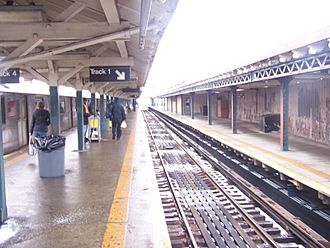
You can get to Van Cortlandt Park by subway. The eastern side is served by the Woodlawn station (4 train), and the western side by the 242nd Street station (1 train). The 242nd Street station opened in 1908 as part of the first subway line. The Woodlawn station opened in 1918.
Buses also serve the park, including the New York City Bus Bx9, Bx10, Bx16, Bx34 local routes, and BxM3, BxM4 express routes. The Bee-Line Bus System also has routes (1, 2, 3, 4, 20, and 21) that go to Westchester.
In Popular Culture
Van Cortlandt Park has appeared in many stories and films.
- In the Nero Wolfe detective stories by Rex Stout, bodies are found in the park.
- In Sol Yurick's 1965 novel The Warriors, a meeting of New York street gangs takes place in the park. In the 1979 film, one of the gangs is even called "The Van Cortlandt Rangers."
- The park is mentioned in William Kotzwinkle's 1974 book The Fan Man.
- In Philip Kaufman's 1979 film The Wanderers, a football game happens at Van Cortlandt Park, though it wasn't filmed there.
- In José Rivera's play Marisol, the park is mentioned in a dark way.
See also
 In Spanish: Van Cortlandt Park para niños
In Spanish: Van Cortlandt Park para niños
- List of NCAA Division I baseball venues
- Delaware Tribe of Indians


